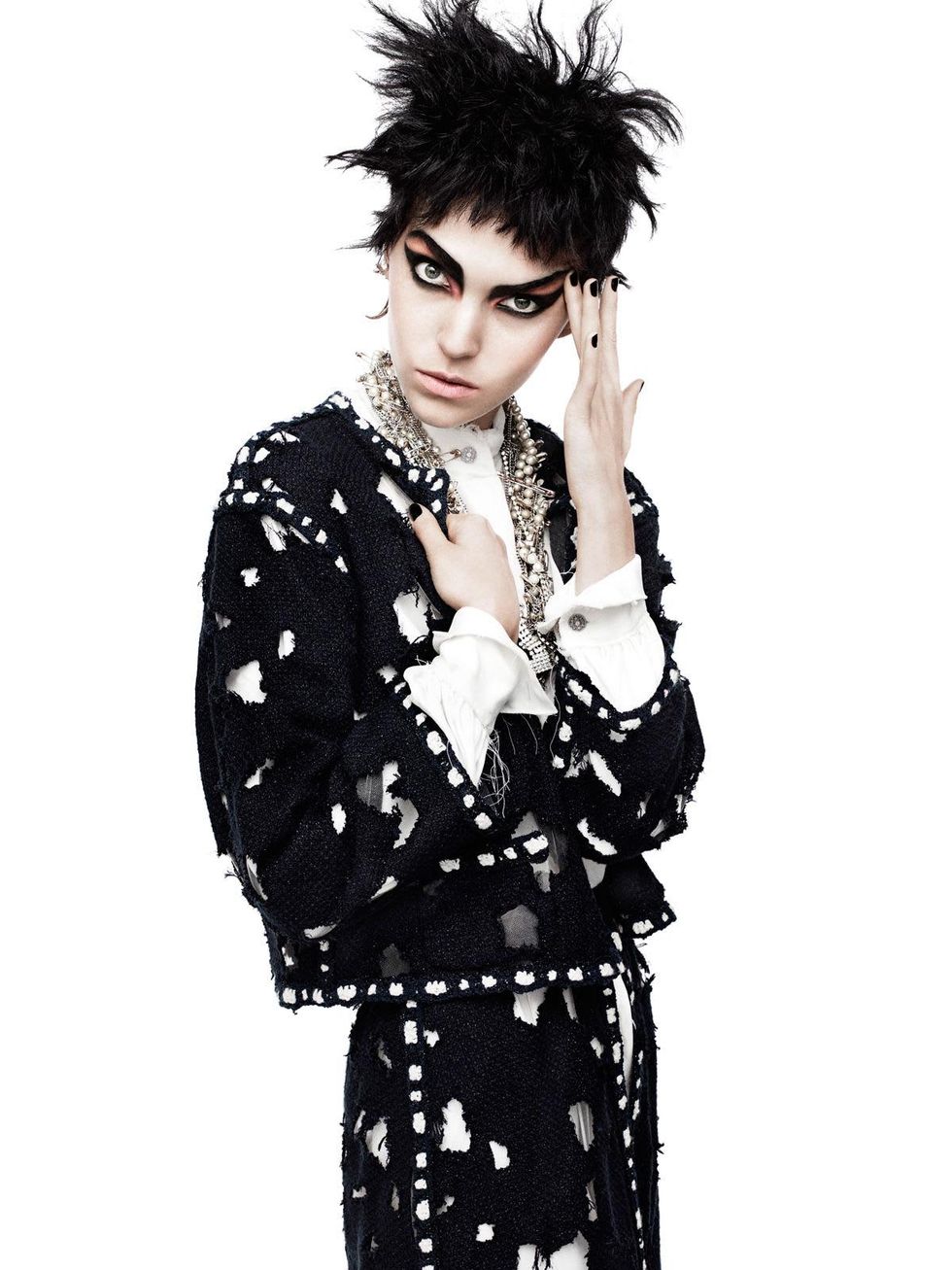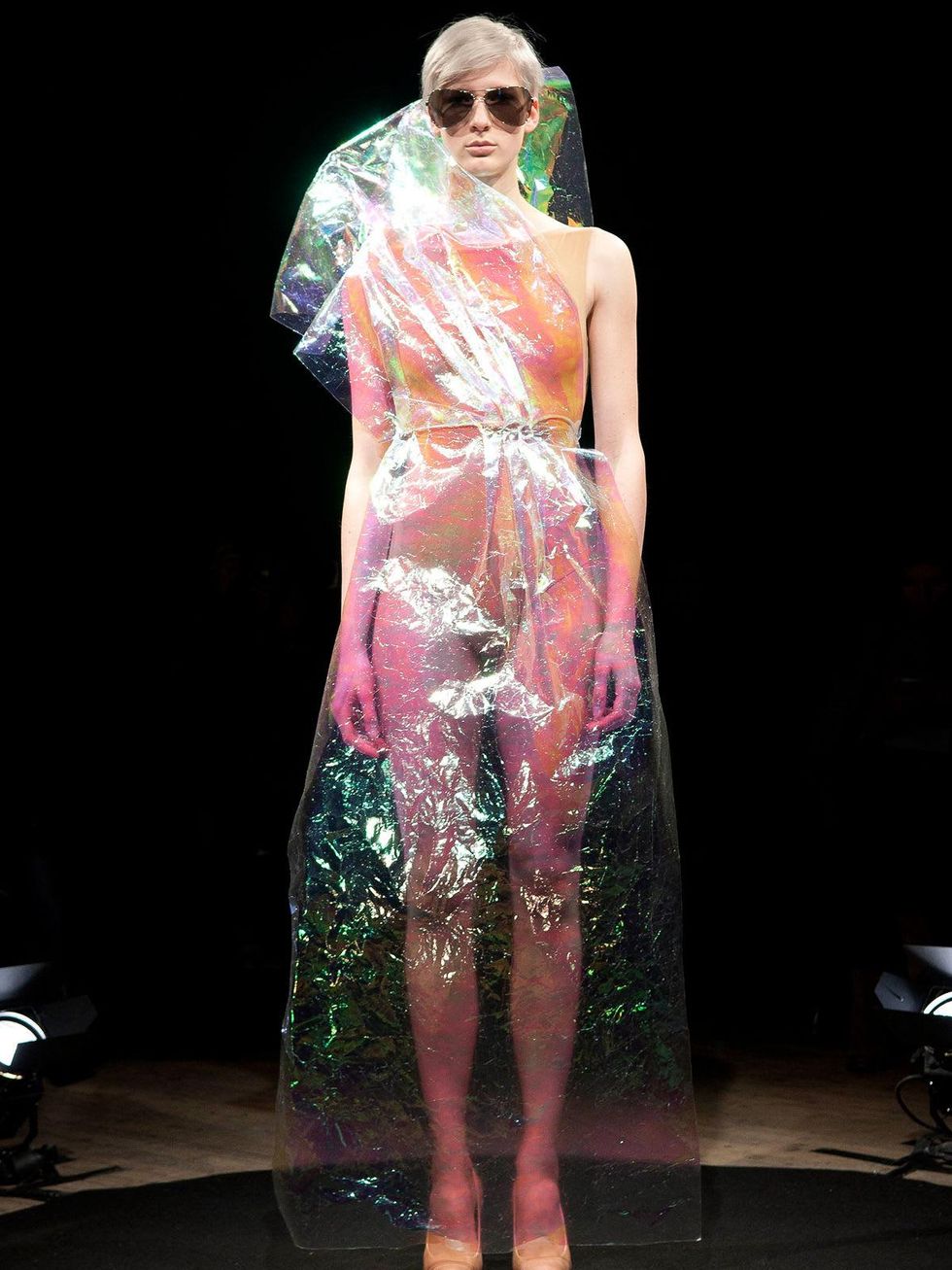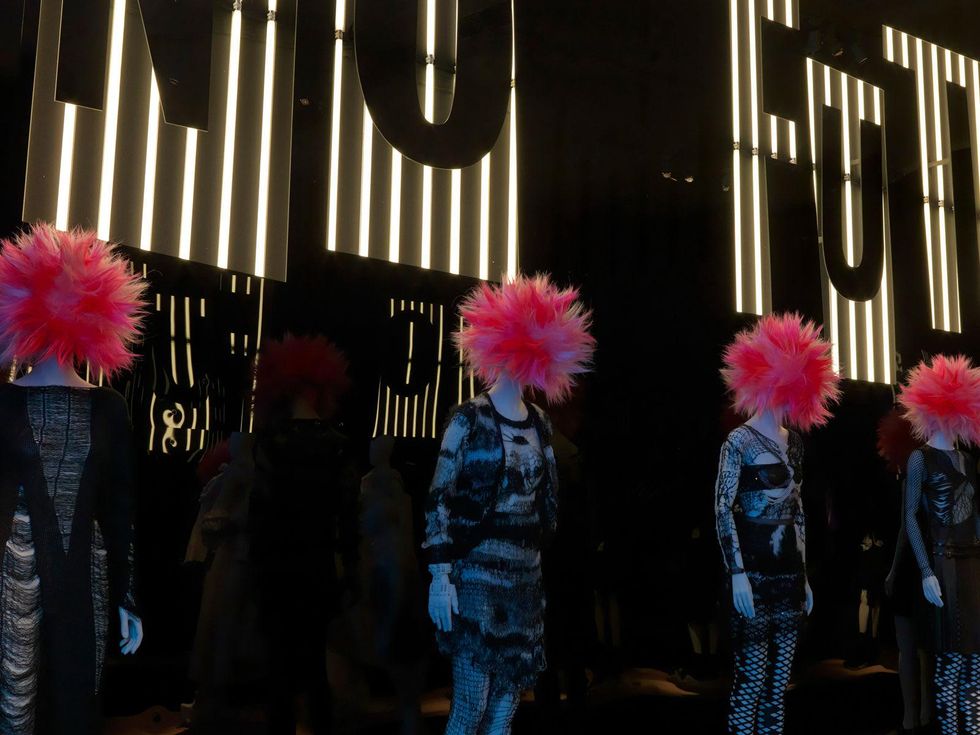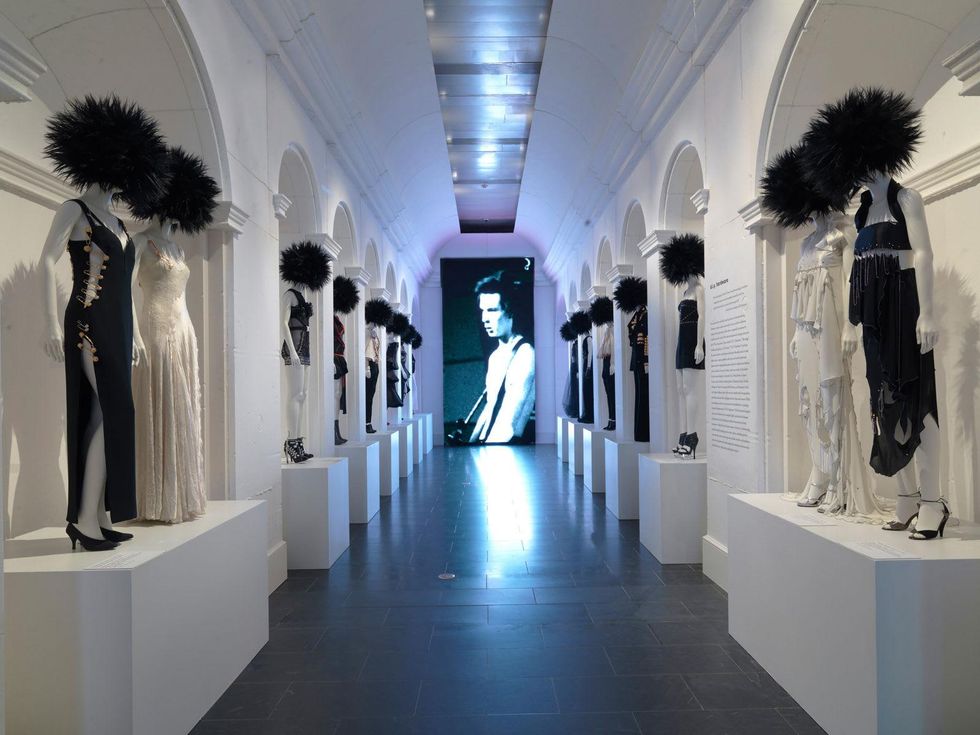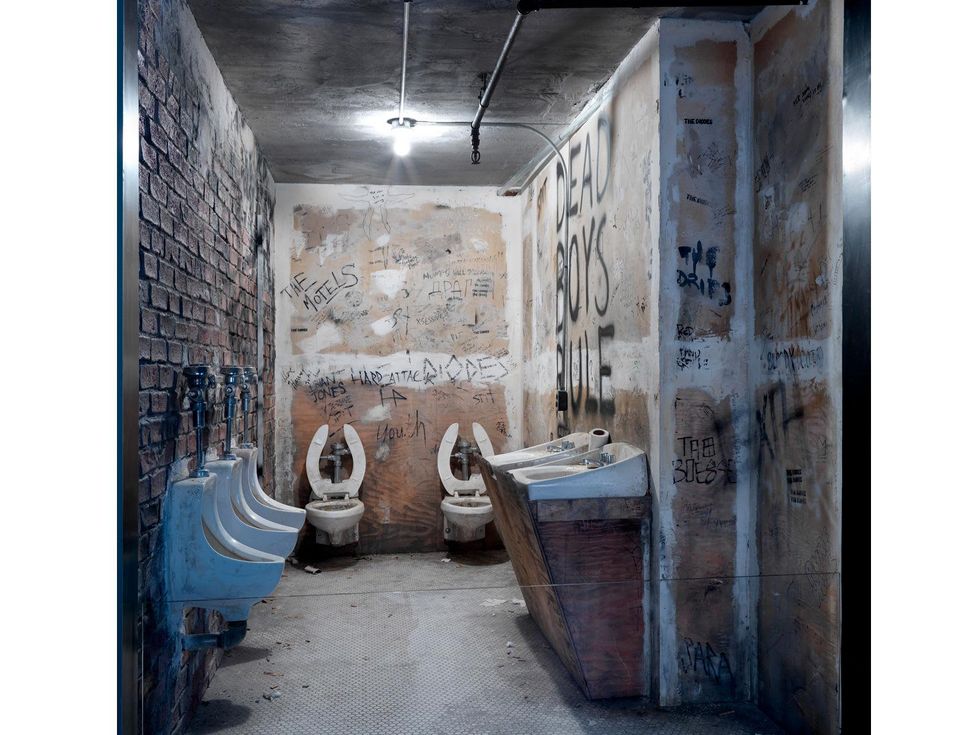Outsider fashion
Punk times are back: New NYC fashion exhibit shows off spiked hair, safety pins and more
NEW YORK — There are, no doubt, more than a few people in this town who thought — misguidedly — they’d never have to face the urinals at CBGB again. But there they are, in all their grimy glory, recreated with the requisite stains, the sinks opposite with those faucets you probably don’t want to touch, and all around them on the walls graffiti — lots of it.
Weirder still — we’re at the Metropolitan Museum of Art.
The infamous CBGB restroom — lovingly recreated from images of the real thing — is just one of the many intriguing sights at the new exhibit, “Punk: Chaos to Couture,"which runs through Aug. 14 at the Metropolitan Museum of Art’s Costume Institute.
Dior, Chanel, Givenchy, Versace, Moschino, Dolce & Gabbana, Thom Browne, Vivienne Westwood, Alexander McQueen and more are all represented — tattered ball gowns, leather harnesses, inside-out pants. Not your standard office attire.
But back to the bathroom.
Actually, it’s easy to get lost in a reverie at this exhibit—even if you were too young to actually have been part of the punk movement.
The decades-old graffiti seems almost quaint (“Mumps will program you,” “youth,” “spit” and “Greg [whoever he was] was here”). Familiar strains waft from overhead speakers. Hear it? It’s The Ramones singing “Now I Wanna Sniff Some Glue” and “Judy is a Punk.” Ahh, memories.
Actually, it’s easy to get lost in a reverie at this exhibit — even if you were too young to actually have been part of the punk movement.
“What’s particularly interesting is how so many people feel ownership of this movement, whether they were a part of it or not,” says curator Andrew Bolton.
Zandra Rhodes might agree. The British designer’s 1977 collection was one of the first notable lines to include safety pins, shredding and the like.
“Everyone thinks a safety pin is something ghastly, and should not be seen,” she says, standing beside two of her dresses on display at the exhibit — one black, one white, both slashed with holes and adorned with safety pins.
“I thought—why not make them like beads,” she says. “Why shouldn’t a tear, a safety pin and a chain look as good as a row of beading?”
Rhodes has in recent years taken on the opera world, designing inventive sets and costumes for various operas, including Verdi’s Aida, which premiered at Houston Grand Opera in 2007. It’s headed back there this October.
Her take on punk, then and now, is . . . wry.
“They’re quite ordinary people,” she says of many of the hard-edged punks from back in the day. “Making middle-aged music.”
She’s smiling ‘neath her hot pink bob.
Where it began
The punk movement began in the mid 1970s, most agree, at the rowdy rock ‘n’ roll club CBGB in lower Manhattan, and Seditionaries, a boutique run by young punks Vivienne Westwood and Malcolm McLaren.
That boutique is also recreated — and looks remarkably kempt. Of course, a slight clue of hard-living is perhaps found on the door. Read the hours, and you see the place on 430 Kings Road in London’s Chelsea was open 11 a.m. to 6 p.m. on weekdays, but only till 3 p.m on. Saturdays. Presumably, they had to rest up for a raucous Saturday night.
Plenty of museum-goers will have sharp views on whether any kind of exhibition on punk—a movement as anti-establishment as you can get—can possibly be done at an icon of the established order, like the Met.
The period elicits a strong sense of ownership. Plenty of museum-goers will no doubt have sharp views on whether any kind of exhibition on punk — a movement as anti-establishment as you can get — can possibly be done at an icon of the established order, like the Met.
Bolton’s anticipating all that. The idea, he says, is not to DEFINE punk, or provide a painstaking chronology of punk events, but to show how a slew of high-end designers got the message, and incorporated this street aesthetic into their — yes, often incredibly high-priced . . . and there’s something more than a little ironic about that — collections.
So rather than show ACTUAL garments worn by punks — no shredded tees from Sid Vicious or Patti Smith, which Bolton admits would “lose their vitality” in a museum setting — they opt to show the punks in gritty, grainy videos, alongside mannequins in spike-haired wigs.
It’s particularly hilarious — it must be said — that the man responsible for setting up this show looks more like Opie Taylor (the cherubic son on classic TV’s Andy Griffith Show— Oscar-winning director Mr. Ron Howard, to you and me) than actual grown-up Opie.
So did the preppy Brit curator with nary a hair out of place ever have a punk moment?
“I was too young,” he admits. But he remembers seeing pictures of punks in the media, “and I was slightly terrified,” he says. But he also came to greatly respect the punk attitude about life. “You should just live your life. Be honest.”
Outsider fashion
At a press conference held before the exhibit opened, Bolton noted that “fashion is the first to acknowledge the outsider,” so it makes sense so many designers started incorporating punk elements in their work. The exhibit offers great examples.
Must-sees include Moschino’s dot tulle gown with safety pins arrayed in a surprisingly graceful pattern, like flowers or snowflakes. Gareth Pugh’s garbage bag gowns, coats and stoles. A Maison Martin Margiela vest of porcelain plate shards held together with wire. Alexander McQueen’s spray-painted dresses and Dior’s crisp white button-down shirts for men, which look like the wearer was shot and bled a stain of red and black beads.
The final gallery is like a breath of fresh air — with deconstructed ivory garments and distressed mohair knits. Overhead, you hear — no, not Johnny Rotten or the Sex Pistols (they’re heard elsewhere) — but King’s College Choir of Cambridge performing “Zadoc the Priest.”
Zadoc the who?
Composed by Handel, with text from the King James Bible, it was performed at Queen Elizabeth II’s coronation — and Bolton thinks it’s a cheeky way to end the show.
“One of the most famous songs The Sex Pistols did was ‘God Save the Queen,’” he says, smiling. “So the idea of flipping that, and using music that was used at the queen’s coronation we thought was like a nice punk ending.”
